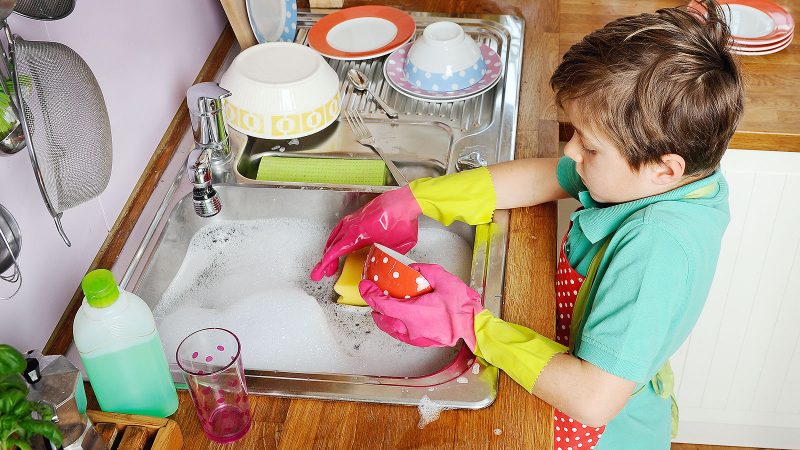
Among the memorable milestones of parenting a child, few are so underrated but also so delicious as the moment we realize our child is not only doing something independent of us but that their task is also helpful. It’s a moment worth celebrating when a young person in the family transitions from being helped to helping out the entire family, even in the smallest and earliest ways, like a team member.
This does not tend to happen by accident, and it doesn’t happen all at once. It is something we parents help to grow in them, primarily by example, one simple task at a time––but these moves toward independence can often happen much earlier than a parent realizes. Children begin imitating their parents and doing household chores as early as preschool and even during their toddler years. Kids want to learn about the things we grown-ups know and do, and they gain their own identity in that process. By giving up some of our very experienced control in favor of patience and flexibility, we help our young people learn to help us right back. It’s also the healthiest way to grow a child into a mature and responsible adult who understands that their contributions are needed and wanted by others.
When our own family moved from a suburban neighborhood to a close-in rural property with livestock in southwestern Oregon, the kids, though still in elementary school, each had to take on a lot more meaningful work in the house and on the property out of simple necessity. I am the one who learned a lesson then about parenting that I became eager to share with other parents everywhere ever after: kids can do so much more than we tend to let them!
Child development experts such as Jean Piaget, Maria Montessori, and Lev Vygotsky contributed much to the large body of understanding about how children move successfully into independence. If we have more time and help around the house we might even find ourselves freed up to read some of those wise words.
So how do we shorten the learning curve to create a helper at any age, and even when they don’t grow up on a farm? We raise our expectations while at the same time growing our own patience, and we can use a method that we will remember more easily, such as show-help-watch-release. Follow this more detailed description below for best long-term results.
First, prepare yourself:
- Determine the chore you will assign.
- Be sure to choose a task that is indeed age-appropriate and likely to succeed, especially early on.
- Be sure to choose a task that you will allow the child to do differently than you do it.
- (How badly do you want some help and mature kids? Flexible parents receive more help.)
- Even young children can help with dishes, tidy areas, fold laundry, sweep, or wipe surfaces.
- Break down the steps of the chore.
- Think ahead about the smaller parts that make up the entire task.
- See the task through your child’s eyes, size, and developmental stage.
- Decide which parts of the task may require assistance or modified tools for a time.
- Write down the steps in order or, for younger children especially, create pictures.
- Consider what motivates this child.
- Each of us rabbits chases different carrots.
- Goal-setting and achievement? Use a chore chart.
- Words of praise? Have some authentic phrases at the ready.
- Together time? Make a lovely date of it.
- Curiosity? Be willing to further explore the parts of the task that excite them most.
- Autonomy? Decide the parts of the task where you can offer more freedom of choice.
- Discuss the plan with your child in advance.
- Share sincere excitement that they are old enough to learn this new thing with you!
- Convey only confidence in them at every stage of this instruction.
- (Critical parents don’t receive as much help as encouraging parents.)
- Describe what it will look and feel like when they are able to do the task on their own.
- Ready yourself psychologically.
- Decide now that you will choose only patience and repetition for as long as that takes.
- Remember: we all learn with practice; special needs may require much more repetition.
- (Time passes equally for the serene as for the impatient; only the experience differs.)
- Think through the steps where you anticipate needing greater patience or encouragement.
The Stages of Show-Help-Watch-Release:
- Show: model the task while your child watches.
- Show them how you do it, step by step, in tandem with your list or pictures.
- Explain in simple terms why you do it the way you do.
- Reassure them they will eventually be able to do it easily also.
- Explain: even simple things can feel hard at first, but we all do hard things with practice.
- Help: use the buddy system to allow the child to do the task while you help with guidance.
- Keep the tone only positive, encouraging, and emotion-free.
- Tell them what they are specifically doing correctly.
- Correct only where absolutely necessary and then do so with simplicity and clarity.
- Keep the steps simple and the chatter minimal, focusing on what you want to learn.
- Watch: be hands-free and allow the child to do the task independently.
- Step in only with your voice––again, you’re also growing your own patience here.
- Encourage them with sincerity if they question themselves or fear criticism.
- Be genuine and specific in your praise about what they do correctly and well.
- Support in tandem on repeat only until you are both confident.
- Readiness may require mere minutes or days or may take weeks, months, or even years.
- (These stages are a process, not a timeline.)
THEN
- Release: relinquish control over the task to the child.
- Acknowledge their competence at this task.
- Announce their readiness to continue in independence.
- Give them ownership and clarity about their part of the task’s routine responsibility.
- Let them know you are available to them for touch-up support or encouragement.
- Do not step in and “fix” what is not a danger or ineffective but is merely done differently.
- (Grateful parents leave well enough alone and even thank their helpers.)
- Acknowledge your own accomplishment of patience and mentorship. Good job, Team!
When a child moves into a new role of helping with another one of the household’s chores, you will likely find yourself celebrating for each of you on the inside, but be sure to celebrate openly together and as a family, as well. You, your child, and your family crossed another milestone together, and everyone in your home will benefit from that growth.

Traci NW (northwest) brings the SW region of Oregon closer to you from her generational hometown of Ashland in the Rogue Valley. She is a freelance writer and a licensed teacher with her MA from CU-Boulder (officially in Education, unofficially in skiing). The paperweight on her writing desk is a cat named Maya that does tricks. You can contact Traci directly at www.tracinw.com
